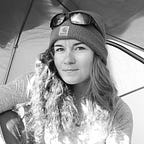From Punta Arenas to Palmer Station
The Drake Passage is known as one of the roughest bodies of water on the planet, but we got lucky during our crossing.
Day One: Punta Arenas Port
As we load box after box of “freshies” (fresh fruits, vegetables, milk, and eggs), the morning’s drizzling rain and thick cloud cover finally clears and the sun comes out. Spirits are high. About 30 people (three science teams and a couple crew members) form a human chain to pass all the cargo from the truck to the ramp to the storage room. The air resonates with jokes, laughter, music, and dancing — physical manifestations of the immense excitement and anticipation that accompanies the start of an expedition.
During our safety briefing, Eric, the Antarctic Support Contract (ASC) manager, reviews all the rules and regulations for living safely and comfortably on the R/V Laurence M. Gould (LMG).
Wear close-toed shoes at all times. Wash your hands frequently. Don’t slam your fingers in the water-tight doors. If an alarm sounds, treat it like a real emergency.
He assures us there are no stupid questions and that the number one priority on the ship is always safety. For those of us traveling to Antarctica for the first time (and there are several of us on board) these words come as a welcome comfort.
Day Two: The Straight of Magellan
As the LMG departs Punta Arenas, we settle in and get to know our fellow passengers. Our group (“the whalers”) will stay on board for the entirety of the next five weeks, but we have two other groups along for part of the ride. The first is a team of biologists from the University of Alabama at Birmingham. They’re heading to Palmer Station to spend the next four months scuba diving and studying the chemical ecology of the macro algae under the ice there.
The other group is a team of coastal geologists from the University of California at Santa Barbara. They are planning to camp on the ice for two weeks at Joinville Island to study changes in sea level rise over the past few thousand years.
After we depart from Palmer, the LMG will turn around, and head north to drop off the geology team. It will take the better part of two days to off-load the team and all the gear they need to survive on the ice for two weeks. Then we’ll spend the next 12 days tagging as many whales as possible.
But for now, we’re all together — enjoying the company and calm seas as we sail past the last bit of South America.
Day Three and Four: The Drake Passage
The morning sky reverberates vivid hues of fiery orange and cotton-candy pink. As I snap photos of the sunrise, the water below appears more like ripples than waves. I can’t believe how calm it is.
Less than an hour later, gray skies roll in, accompanied by a light drizzle and the rolling waves of the open Southern Ocean.
Activity around the boat dissipates as people hunker down in preparation for the roughest part of the crossing. We secure everything on the boat — from equipment to furniture to computers. My camera bag goes into a cabinet. My laptop goes into a drawer. I watch an orange roll back and forth as the ship rocks side to side.
Day Five: The Antarctic Peninsula
“Look — there are two — no, three fin whales just off the starboard bow,” Dave Cade says, handing me a set of binoculars.
Our whole team is gathered on the bridge (where the captain and his crew have kindly welcomed us to access the best vantage point of the ship.) We spend the next several hours logging whale sightings and taking photos. Sometimes the whales appear just barely visible, over a mile or two away — a speck on the horizon.
Other times, they pop up right next to the boat.
In one day — roughly a 14 hour period — we log just over 100 sightings, about 300 whales in total. The vast majority are fin whales and humpbacks, but we also see a few killer whales. No minke whales yet.
We take this as a good omen — the minkes are waiting for us.
